Stabilizing proteins from sequence statistics: the interplay of conservation and correlation in triosephosphate isomerase stability
- PMID: 22555051
- PMCID: PMC3578383
- DOI: 10.1016/j.jmb.2012.04.025
Stabilizing proteins from sequence statistics: the interplay of conservation and correlation in triosephosphate isomerase stability
Abstract
Understanding the determinants of protein stability remains one of protein science's greatest challenges. There are still no computational solutions that calculate the stability effects of even point mutations with sufficient reliability for practical use. Amino acid substitutions rarely increase the stability of native proteins; hence, large libraries and high-throughput screens or selections are needed to stabilize proteins using directed evolution. Consensus mutations have proven effective for increasing stability, but these mutations are successful only about half the time. We set out to understand why some consensus mutations fail to stabilize, and what criteria might be useful to predict stabilization more accurately. Overall, consensus mutations at more conserved positions were more likely to be stabilizing in our model, triosephosphate isomerase (TIM) from Saccharomyces cerevisiae. However, positions coupled to other sites were more likely not to stabilize upon mutation. Destabilizing mutations could be removed both by removing sites with high statistical correlations to other positions and by removing nearly invariant positions at which "hidden correlations" can occur. Application of these rules resulted in identification of stabilizing mutations in 9 out of 10 positions, and amalgamation of all predicted stabilizing positions resulted in the most stable yeast TIM variant we produced (+8 °C). In contrast, a multimutant with 14 mutations each found to stabilize TIM independently was destabilized by 2 °C. Our results are a practical extension to the consensus concept of protein stabilization, and they further suggest the importance of positional independence in the mechanism of consensus stabilization.
Copyright © 2012 Elsevier Ltd. All rights reserved.
Figures

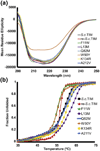


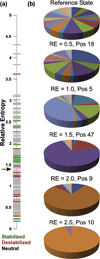
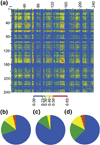
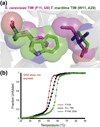
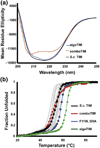
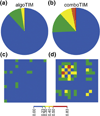
Similar articles
-
Triosephosphate isomerase by consensus design: dramatic differences in physical properties and activity of related variants.J Mol Biol. 2011 Oct 14;413(1):195-208. doi: 10.1016/j.jmb.2011.08.001. Epub 2011 Aug 4. J Mol Biol. 2011. PMID: 21839742
-
Phylogenetic spread of sequence data affects fitness of consensus enzymes: Insights from triosephosphate isomerase.Proteins. 2020 Feb;88(2):274-283. doi: 10.1002/prot.25799. Epub 2019 Sep 13. Proteins. 2020. PMID: 31407418
-
Design, creation, and characterization of a stable, monomeric triosephosphate isomerase.Proc Natl Acad Sci U S A. 1994 Feb 15;91(4):1515-8. doi: 10.1073/pnas.91.4.1515. Proc Natl Acad Sci U S A. 1994. PMID: 8108439 Free PMC article.
-
A guide to the effects of a large portion of the residues of triosephosphate isomerase on catalysis, stability, druggability, and human disease.Proteins. 2017 Jul;85(7):1190-1211. doi: 10.1002/prot.25299. Epub 2017 Apr 27. Proteins. 2017. PMID: 28378917 Review.
-
Protein stability by number: high-throughput and statistical approaches to one of protein science's most difficult problems.Curr Opin Chem Biol. 2011 Jun;15(3):443-51. doi: 10.1016/j.cbpa.2011.03.015. Epub 2011 Apr 15. Curr Opin Chem Biol. 2011. PMID: 21498105 Free PMC article. Review.
Cited by
-
Dissecting enzyme function with microfluidic-based deep mutational scanning.Proc Natl Acad Sci U S A. 2015 Jun 9;112(23):7159-64. doi: 10.1073/pnas.1422285112. Epub 2015 May 26. Proc Natl Acad Sci U S A. 2015. PMID: 26040002 Free PMC article.
-
The use of consensus sequence information to engineer stability and activity in proteins.Methods Enzymol. 2020;643:149-179. doi: 10.1016/bs.mie.2020.06.001. Epub 2020 Jul 17. Methods Enzymol. 2020. PMID: 32896279 Free PMC article.
-
Automated Structure- and Sequence-Based Design of Proteins for High Bacterial Expression and Stability.Mol Cell. 2016 Jul 21;63(2):337-346. doi: 10.1016/j.molcel.2016.06.012. Epub 2016 Jul 14. Mol Cell. 2016. PMID: 27425410 Free PMC article.
-
Consensus design for improved thermostability of lipoxygenase from Anabaena sp. PCC 7120.BMC Biotechnol. 2018 Sep 20;18(1):57. doi: 10.1186/s12896-018-0468-4. BMC Biotechnol. 2018. PMID: 30236091 Free PMC article.
-
Customized multiple sequence alignment as an effective strategy to improve performance of Taq DNA polymerase.Appl Microbiol Biotechnol. 2023 Nov;107(21):6507-6525. doi: 10.1007/s00253-023-12744-5. Epub 2023 Sep 1. Appl Microbiol Biotechnol. 2023. PMID: 37658164
References
-
- Dill KA. Dominant forces in protein folding. Biochemistry. 1990;29:7133–7155. - PubMed
-
- Rose GD, Wolfenden R. Hydrogen bonding, hydrophobicity, packing, and protein folding. Annu. Rev. Biophys. Biomol. Struct. 1993;22:381–415. - PubMed
-
- Cordes MH, Davidson AR, Sauer RT. Sequence space, folding and protein design. Curr. Opin. Struct. Biol. 1996;6:3–10. - PubMed
Publication types
MeSH terms
Substances
Grants and funding
LinkOut - more resources
Full Text Sources
Other Literature Sources
Molecular Biology Databases

